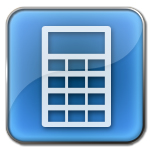Basics of Business Math

This series covers basic mathematical calculations commonly used in business settings. Courses cover computing fractions and decimals, the order of operations for combined computations, and solving equations and word problems. It includes the use of proportions, ratios, and percentages, and also provides instruction on the use of a calculator for business applications.
Audience:
This series is designed for users who want to improve their basic math skills.
This series is designed for users who want to improve their basic math skills.
Features:
- Exercises allow learners to practice in the actual application being studied.
- A Course Topics list contains active hyperlinks, permitting quick access to specific topics.
- Find-A-Word allows learners to look up an unfamiliar term in the Glossary, on the Web, or in a dictionary. In addition, it lets them find other occurrences of the term in the same course.
- Search text enables learners to rapidly search all text within a course to easily retrieve information required.
- Courses challenge the learner with a variety of question formats, including multi-step simulations, true/false, multiple choice, and fill-in-the-blank.
- A skill assessment generates a customized learning path based on the results of a pre-test.
- A glossary provides a reference for definitions of unfamiliar terms.
- Bookmarking tracks the learner's progress in a course.
Click on the titles below to show/hide included course information if the tooltips go out of view.
Summary:
This course provides instruction and practice in using a calculator for business math.
Objectives:
- Add, subtract, multiply, and divide with a calculator
- Use the constant function
- Multiply and divide by fractions
- Use the percent key to do percent calculations
- Solve squares and square roots
- Perform chain calculations and combined operations
- Use common formulas to perform financial calculations
Topics:
- Fundamentals
- Other Basic Operations
- The Percent Key
- More Special Keys
- Combined Operations
- Combined Formulas
- Course Review
Technical Requirements:
P500+ Processor, 128MB of RAM; Windows 2000, 2003, XP, Vista, Minimum screen resolution 800x600, Internet Explorer 5.5 or higher; Windows Media Player 9.0 or higher; Flash 8.0 or higher; 56K minimum connection; broadband (256 kpbs or higher) connection recommended; Javascript, DHTML and cookies enabled; Sound card with speakers or headphones strongly recommended.
Summary:
This course teaches how to add, subtract, multiply, and divide using decimals. It also shows the order in which to do this for combined computations.
Objectives:
- Compare decimals and round decimals to the nearest tenth and nearest hundredth
- Add, subtract, multiply, and divide decimals
- Perform combined addition, subtraction, multiplication, and division problems using the rules of order
- Solve math problems using decimals
Topics:
- Overview
- Adding and Subtracting
- Multiplying Decimals
- Dividing with Decimals
- Combined Computations
- Course Review
Technical Requirements:
P500+ Processor, 128MB of RAM; Windows 2000, 2003, XP, Vista, Minimum screen resolution 800x600, Internet Explorer 5.5 or higher; Windows Media Player 9.0 or higher; Flash 8.0 or higher; 56K minimum connection; broadband (256 kpbs or higher) connection recommended; Javascript, DHTML and cookies enabled; Sound card with speakers or headphones strongly recommended.
Summary:
This course discusses equations and ratios. It teaches what equations and ratios are and how to use them to solve many different word problems.
Objectives:
- Solve simple equations
- Solve word problems by using formulas
- Create ratios to express the relationship between two amounts
- Use proportions to solve problems involving comparisons of ratios
- Solve math problems using ratios and proportions
- Solve math problems using equations
Topics:
- Equations and Formulas
- Inverse Operations
- Word Problems
- Ratios
- Proportions
- Course Review
Technical Requirements:
P500+ Processor, 128MB of RAM; Windows 2000, 2003, XP, Vista, Minimum screen resolution 800x600, Internet Explorer 5.5 or higher; Windows Media Player 9.0 or higher; Flash 8.0 or higher; 56K minimum connection; broadband (256 kpbs or higher) connection recommended; Javascript, DHTML and cookies enabled; Sound card with speakers or headphones strongly recommended.
Summary:
This course provides instruction and practice in basic business math skills for the area of fractions.
Objectives:
- Recognize how to add, subtract, multiply, and divide fractions
- Explain how to write equal fractions
- Solve combined computations
- Use fractions to solve application problems
Topics:
- Basics of Fractions
- Equal Fractions
- Adding and Subtracting Fractions
- Mixed Numbers
- Multiplying Fractions and Mixed Numbers
- Dividing Fractions
- Combined Computations
- Course Review
Technical Requirements:
P500+ Processor, 128MB of RAM; Windows 2000, 2003, XP, Vista, Minimum screen resolution 800x600, Internet Explorer 5.5 or higher; Windows Media Player 9.0 or higher; Flash 8.0 or higher; 56K minimum connection; broadband (256 kpbs or higher) connection recommended; Javascript, DHTML and cookies enabled; Sound card with speakers or headphones strongly recommended.
Summary:
This course teaches how to calculate percents. It explains how to convert decimals to percents, percents to decimals, fractions to percents, and percents to fractions. This course also teaches how to solve word problems involving percentages by using formulas.
Objectives:
- Convert a decimal to a percent and a percent to a decimal
- Convert decimals to fractions, fractions to decimals, and fractions to percents
- Define the terms base, rate, and percentage and identify them in word problems
- Solve math problems using percents
Topics:
- Introduction to Percents
- Reviewing Conversion Rules
- Converting to and from Percents
- Percentages
- Word Problems
- Course Review
Technical Requirements:
P500+ Processor, 128MB of RAM; Windows 2000, 2003, XP, Vista, Minimum screen resolution 800x600, Internet Explorer 5.5 or higher; Windows Media Player 9.0 or higher; Flash 8.0 or higher; 56K minimum connection; broadband (256 kpbs or higher) connection recommended; Javascript, DHTML and cookies enabled; Sound card with speakers or headphones strongly recommended.
Summary:
This course provides instruction in evaluating and analyzing basic statistics and graphs used in business reports.
Objectives:
- Define mean, median, and mode
- Calculate a simple average
- Determine the type of average that best represents the measure of central tendency
- Distinguish between a simple average and a weighted average
- Calculate a weighted average
- Identify various types of graphs and charts
- Read and interpret graphs
- Select appropriate graphs
Topics:
- Simple Averages
- Weighted Averages
- Identifying Graphs and Charts
- Reading Graphs
- Selecting Graphs
Technical Requirements:
P500+ Processor, 128MB of RAM; Windows 2000, 2003, XP, Vista, Minimum screen resolution 800x600, Internet Explorer 5.5 or higher; Windows Media Player 9.0 or higher; Flash 8.0 or higher; 56K minimum connection; broadband (256 kpbs or higher) connection recommended; Javascript, DHTML and cookies enabled; Sound card with speakers or headphones strongly recommended.
Our training is available 24 hours a day, 365 days a year. Smart Horizons changes the way companies train their employees, bringing lower costs, and higher quality training to employees across town or around the world.
Product Features
Total Hours: 16
Annual Subscription
Purchasing Options
OUR PRICE
$72.00
EACH
$72.00
EACH
